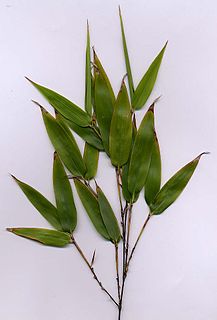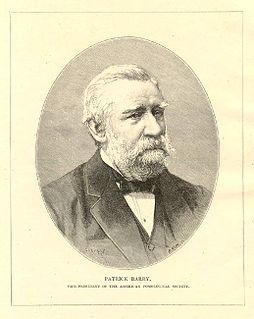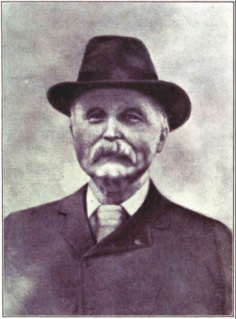
Guava is a common tropical fruit cultivated in many tropical and subtropical regions. The common guava Psidium guajava is a small tree in the myrtle family (Myrtaceae), native to Mexico, Central America, the Caribbean and northern South America. The name guava is also given to some other species in the genus Psidium such as strawberry guava and to the pineapple guava, Feijoa sellowiana. In 2019, 55 million tonnes of guavas were produced worldwide, led by India with 45% of the total. Botanically, guavas are berries.

Will Alfred Theodore Ingwersen, was a British nurseryman and alpine specialist. He was an authority on alpine plants, and an expert on rock gardens.

Arbutus unedo is an evergreen shrub or small tree in the family Ericaceae, native to the Mediterranean region and western Europe. The tree is well known for its fruits, which bear some resemblance to the strawberry—hence the common name "strawberry tree". However, it is not closely related to true strawberries of the genus Fragaria.

Camellia japonica, known as common camellia, or Japanese camellia, is a species of flowering plant in the family Theaceae. There are thousands of cultivars of C. japonica in cultivation, with many colors and forms of flowers. In the U.S. it is sometimes called japonica. In the wild, it is found in mainland China, Taiwan, southern Korea and southwestern Japan. It grows in forests, at altitudes of around 300–1,100 metres (980–3,600 ft). Camellias are famous throughout East Asia; they are known as tsaa4 faa1 in Cantonese, cháhuā (茶花) in Mandarin Chinese, tsubaki (椿) in Japanese, dongbaek-kkot (동백꽃) in Korean, and as hoa trà or hoa chè in Vietnamese.

The Loddiges family managed one of the most notable of the eighteenth and nineteenth century plant nurseries that traded in and introduced exotic plants, trees, shrubs, ferns, palms and orchids into European gardens.

Ulmus × hollandica 'Vegeta', sometimes known as the Huntingdon Elm, is an old English hybrid cultivar raised at Brampton, near Huntingdon, by nurserymen Wood & Ingram in 1746, allegedly from seed collected at nearby Hinchingbrooke Park. In Augustine Henry's day, in the later 19th century, the elms in Hinchingbrooke Park were U. nitens. Richens, noting that wych elm is rare in Huntingdonshire, normally flowering four to six weeks later than field elm, pointed out that unusually favourable circumstances would have had to coincide to produce such seed: "It is possible that, some time in the eighteenth century, the threefold requirements of synchronous flowering of the two species, a south-west wind", "and a mild spring permitting the ripening of the samaras, were met."

The hybrid elm cultivar Ulmus × hollandica 'Dampieri', one of a number of cultivars arising from the crossing of the Wych Elm U. glabra with a variety of Field Elm U. minor, is believed to have originated in continental Europe. It was marketed in Wetteren, Belgium, in 1851 as 'Orme de Dampier', then in the Low Countries in 1853, and later identified as Ulmus campestris var. nuda subvar. fastigiata DampieriHort., Vilv. by Wesmael (1862).

Patrick Barry, was a pioneer horticulturist, owner of the then-largest nursery in the United States, and noted author on the subject of horticulture.

Charles Downing, was an American pomologist, horticulturist, and author.
Daniel John Hinkley is an American plantsman, garden writer, horticulturist and nurseryman. He is best known for establishing Heronswood Nursery, in Kingston, Washington; and Windcliff, on the Kitsap Peninsula near Indianola, WA; and for collecting, propagating, and naming varieties of plants new to the North American nursery trade.
Cassady is a grape variety which is greenish-white in color. It is related to the "Fox Grape", Vitis labrusca, and it is an offspring of an open pollination variant of V. labrusca, which means that it is classified as an interspecific crossing, a hybrid grape. It was first described in the Interim Fruit Report of the Pennsylvania Horticultural Society in November, 1853. The first Cassady grapevine sprang up as a volunteer (unplanted) seedling in the yard of P.H. Cassady at 29 Logan Square, Philadelphia, Pennsylvania, in 1847. It did not bear fruit for five years, but when it finally did, the grapes it produced were found by Cassady to be juicy, pleasantly flavoured, and of very good quality. The Cassady grape was propagated and subsequently crossed with the better-known Concord grape to produce a new white grape variety, the Niagara grape, which is the cultivar most commonly used for the production of white grape juice in North America.
Joseph Breck (1794–1873), a notable businessman and horticulturist of the 19th century, was born in Medfield, Massachusetts. He moved to Pepperell, Massachusetts, in 1817, working in the chaise carriage manufacturing business while also exploring his passion for horticulture in his gardens. His interest in flowers and plants developed into a career as an editor, from 1822 to 1846, of the New England Farmer, one of the earliest agricultural magazines established in the U.S., and the first of its kind in New England.
Tony Avent is an American horticulturist and plantsman. He and wife and business partner, Anita Avent, own Plant Delights Nursery and Juniper Level Botanic Garden in Raleigh, North Carolina. In addition, he is a plant explorer, author and public speaker.

Felix Gillet was a California pioneer nurseryman, horticulturist, sericulturist, and writer who made several important introductions of superior European deciduous fruit and nut trees to California and the northwestern United States. Beginning in 1869, in his Barren Hill Nursery in Nevada City, Gillet cultivated his own imported scion wood and home-grown nursery stock, experimented with grafting and hybridizing, and continually wrote articles on horticulture and his plant selections, while remaining active in Nevada City civic affairs. Publishing his own nursery catalog for 37 years and advertising widely, he sold his walnuts, filberts (hazelnuts), chestnuts, prunes, figs, strawberries, grapes, peaches, cherries, citrus and dozens of other fruit and nut varieties throughout California and the Pacific Northwest. The commercial walnut variety "Felix Gillet" was named in his honor.
James Gordon (1708–1780) was a gardener who became a nurseryman, and later a seed merchant in London, specializing in exotics such as camellia and rhododendron; he is also credited with the introduction of the American Elm, Ulmus americana, in 1752. Appointed gardener to James Sherard at Eltham in 1730, he progressed to Lord Petre's estate at Thorndon Hall, Essex, in 1738 before starting a nursery at Mile End in 1742, later moving to Bow, and establishing a seed shop at Thistle & Crown, 25 Fenchurch Street. His sons, William, James, and Alexander, assumed control of the nursery in 1776. Although a correspondent of Linnaeus, he never wrote works of his own. "He had more knowledge in vegetation than all the gardeners and writers in England put together, but is too modest to publish anything" He died at Barking, Essex, on 20 December 1780.
Hugh Ronalds was an esteemed nurseryman and horticulturalist in Brentford, who published Pyrus Malus Brentfordiensis: or, a Concise Description of Selected Apples (1831). His plants were some of the first European species to be shipped to Australia when the British colony was founded.

Charles Howard Shinn was a horticulturalist, author, inspector of California Experiment Stations, and forest ranger in California.

John Rock was a German-born American horticulturalist and nurseryman. John Rock was a leader in California in pomology and the nursery business from 1865 until his death in 1904. Charles Howard Shinn wrote the entry for John Rock in L.H. Bailey's Cyclopedia of Horticulture He said "John Rock's scientific spirit, his wide and ever-increasing knowledge, his very high standards of business and his unselfishness made him during his long life the leader of Pacific coast nurserymen. He introduced more valuable plants and varieties to American horticulture than any other man of his period. His connection with Japan, India, Australia and with the great establishments abroad was close and constant. He did much to encourage men like Luther Burbank, and his collections were always at the service of students and the public."
Thomas Davey was a British florist and nurseryman based in Camberwell, Surrey, and later in Chelsea, Middlesex, both now in London, England. The son of a nurseryman of the same name, he was known for his "florists' flowers", the type of flowers traditionally popular with English florists, and specialised in tulips, geraniums, and pinks. He capitalised on a new enthusiasm for tulips and flower-growing at the start of the 19th century in what has been described as a "cult of florists' flowers", giving exhibitions that attracted large crowds and publishing sales catalogues, one of which offered nearly 800 different types of tulip bulbs.














